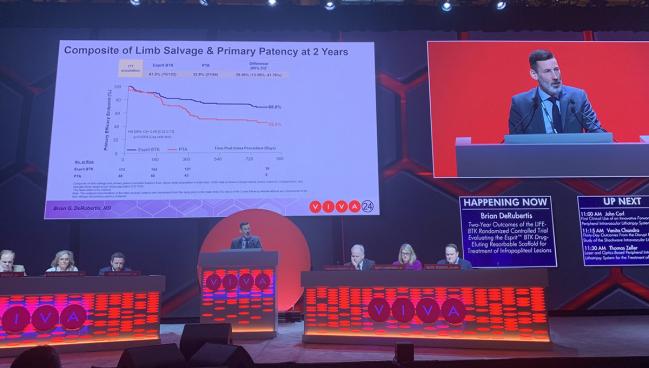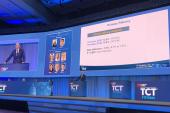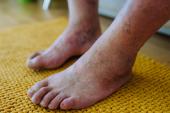Disappearing Scaffold for CLTI Still Works Well at 2 Years: LIFE-BTK
The data thus far suggest fewer repeat interventions with the newly FDA approved resorbable device compared with PTA.

LAS VEGAS, NV—At 2 years, a drug-eluting resorbable scaffold continues to show sustained patency and safety compared with conventional angioplasty alone in patients with below-the-knee (BTK) chronic limb-threatening ischemia (CLTI), new follow-up data from the LIFE-BTK trial show.
The combined primary efficacy endpoint—freedom from above-ankle amputation of the target limb, occlusion of the target vessel, clinically driven revascularization of the target lesion, binary restenosis of the target lesion, and clinically driven target lesion revascularization—was 68.8% in those treated with the everolimus-eluting Esprit BTK (Abbott) and 45.4% in percutaneous transluminal angioplasty (PTA) patients (HR 0.48; 95% CI 0.32-0.73).
Presenting the results here at VIVA 2024, Brian DeRubertis, MD (NewYork-Presbyterian/Columbia University Irving Medical Center, New York, NY), said they are reassuring regarding the safety and lasting therapeutic benefit of the technology.
“The Esprit BTK scaffold significantly reduced binary restenosis, and total occlusion binary restenosis being a significant driver of that endpoint, arguing that the everolimus elution really is an important component of this device to prevent biologic restenosis,” he added.
To TCTMD, LIFE-BTK principal investigator Sahil Parikh, MD (NewYork-Presbyterian/Columbia University Irving Medical Center), pointed to the rates of clinically driven TLR, which were 18.6% in the PTA group at 2 years compared with 9.7% in the scaffold arm (log-rank P = 0.03).
“The durability of this result has never been demonstrated with any BTK technology previously and provides me with reassurance that the signals we saw at 12 months are not only real but are clinically and biologically showing a demonstrable effect of both the scaffold and the drug,” he said.
Earlier this year, the US Food and Drug Administration approved the scaffold on the basis of the 1-year results from LIFE-BTK, making it the only completely dissolvable therapy for use in peripheral interventions. The device consists of a bioresorbable poly-L lactide backbone with thin struts equivalent to contemporary coronary DES and a coating of everolimus.
In his presentation, DeRubertis said that by 2 years, the scaffold body has mostly disappeared. “It's not exerting any effect on the vessel itself and you still have some residual component of the device, but that is fully gone within 3 years,” he noted.
Panelist Marc P. Bonaca, MD (University of Colorado Anschutz Medical Campus, Aurora), another LIFE-BTK investigator, told TCTMD that the excitement around the scaffold is partly due to the sustained benefit in a patient population that often has few treatment options. “It's also very critical to look beyond just the anatomic outcomes, and LIFE-BTK did this,” he said. “We are looking at things [that matter to the patient] including wound healing and patient-reported outcomes.”
Reduced Need for Reintervention
For the multicenter LIFE-BTK trial, investigators enrolled 261 patients (mean age 72.6 years; 32% female) with Rutherford class 4 or 5 CLTI and infrapopliteal artery stenosis or occlusion. Researchers randomly assigned them to receive the everolimus-eluting resorbable scaffold or PTA, with up to two de novo or restenotic target lesions per patient eligible for treatment. All lesions were required to be located in separate arteries in the proximal two-thirds of the infrapopliteal space and have runoff to the ankle that was free of clinically significant disease. Overall, the study cohort had high rates of smoking, hypertension, hyperlipidemia, and prior PAD.
The mean length of treated lesions was 43.7 mm in the scaffold group and 44.7 mm in the angioplasty group. The majority of patients had mild/no calcification, with more than one-quarter in both treatment groups having moderate calcification and 3% in the scaffold group and 2% in the PTA group having severe calcification.
Those receiving the scaffold had 1 year of dual antiplatelet therapy (DAPT) while those in the angioplasty arm received 1 month of DAPT, with single antiplatelet therapy thereafter.
The durability of this result has never been demonstrated with any BTK technology previously. Sahil Parikh
At 2 years, clinical follow-up was available in 87.9% of the scaffold patients and 83% of the PTA patients. The composite of limb salvage and primary patency was 72.7% in the scaffold group versus 55.1% in the PTA group (HR 0.53; 95% CI 0.33-0.84). The occurrence of binary restenosis of the target lesion was 28.5% with the scaffold versus 48.2% with PTA (HR 1.85; 95% CI 1.19-2.88).
For the composite of limb salvage and primary patency without binary restenosis, there was a maintained difference between the treatment groups of approximately 15% between years 1 and 2, favoring the scaffold. A similar maintenance of benefit was seen for the individual endpoint of freedom from clinically driven TLR, with rates of 81.4% for the PTA group versus 90.3% for the scaffold group at 2 years (HR 0.46; 95% CI 0.22-0.96).
“We know that each of our routine interventions take a significant toll on the patient's quality of life and . . . mental health, I would even say,” DeRubertis noted. “So, avoiding these TLRs and avoiding these reinterventions is very important.”
Additionally, the percentage of patients who had more than one clinically driven TLR by 2 years was nearly doubled in the PTA arm compared with the scaffold (4.7% vs 2.4%), although the overall numbers of these patients was small.
The composite safety endpoint, which included major adverse limb events and postoperative death at 30 days, was not different between groups.
Pondering Reinterventions
Panelist Iris Baumgartner, MD (Bern Center for Vascular Medicine and Intervention, Switzerland), noted that the dissolving technology raises questions about best practices for attempting reinterventions in patients who have received scaffolds.
Noting that drug-coated balloons (DCBs) are not available in the United States for BTK interventions, DeRubertis said he thinks the most important issue is that operators follow the methodology described in the trial as the scaffold rolls out into real-world practice.
“I think it's worth noting that we used this as primary therapy, meaning we included full coverage of the lesion and did not allow treatment downstream of the lesion,” he added. “So, one of my concerns in rolling this device out is [there may be a] tendency to use the scaffold proximally . . . and let the rest be treated with angioplasty alone. I think that's not necessarily the wrong strategy, but that's not how we did the trial and I'm not sure if that has the same results.” Specifically, DeRubertis said, not using the scaffold to fully cover the lesion could increase the risk for areas of geographic miss, which in turn could lead to restenosis.
Parikh said in most cases retreatment has been done with PTA or an uncoated stent. He further noted that the scaffolds tend to stay open even if there’s another area that has become occluded.
“So as with most stents, first you have to know that it’s there because it’s not visible. The marker dots that are on either end are a little bit difficult to see unless you magnify the view and look carefully,” he said. “If it’s patent, what we normally do is we try to loop a wire through so that you don’t get underneath the strut, [which] is a tactic that we’ve used forever when crossing stents, both coronary and peripheral. The other thing that is very helpful is imaging.” Even if the device itself isn’t visible on IVUS, “you'll still see where the scaffold has expanded the vessel and you'll have a sense of whether the vessel is perfectly circular,” he explained.
Parikh added that rescaffolding at this point is discouraged, particularly in the first 2 to 3 years when the scaffold is still technically in place, even if it’s mostly dissolved.
Speaking in a separate session in the afternoon about LIFE-BTK, Thomas Zeller, MD, PhD (Universitäts-Herzzentrum Freiburg-Bad Krozingen, Germany), said he disagreed with the idea that the scaffold is a “game changer” in the treatment of BTK disease.
“As long as we are dealing with short lesions and you can guarantee full lesion coverage, it doesn’t matter whether you use a bioresorbable or permanent implant, in my opinion,” he said.
But DeRubertis pushed back, reiterating that the use of DES for BTK interventions in the United States is essentially unnavigable, with device manufacturers opting not to pursue trials that would be needed to gain an indication—unlike in Europe, where DCBs have a CE Mark approval for use in BTK interventions.
“One of the main reasons for that is that many of us, especially on the surgical side, are simply not going to want a permanent implant in the tibial vessels. Those tibial vessels are our last line of defense in terms of bypassing the lesion and saving a foot,” he said.
L.A. McKeown is a Senior Medical Journalist for TCTMD, the Section Editor of CV Team Forum, and Senior Medical…
Read Full BioSources
DeRubertis BG. Two-year outcomes of the LIFE-BTK randomized controlled trial evaluating the Esprit BTK drug-eluting resorbable scaffold for treatment of infrapopliteal lesions. Presented at: VIVA 2024. November 4, 2024. Las Vegas, NV.
Disclosures
- LIFE BTK was funded by Abbott.
- DeRubertis reports honoraria from Abbott Vascular and Medtronic; consulting for Abbott Vascular, Medtronic, Cagent, Boston Scientific, BD, and Concept Medical; and research, clinical trial, or drug study funds to his institution from Abbott Vascular, Cagent, and Concept Medical.





Comments